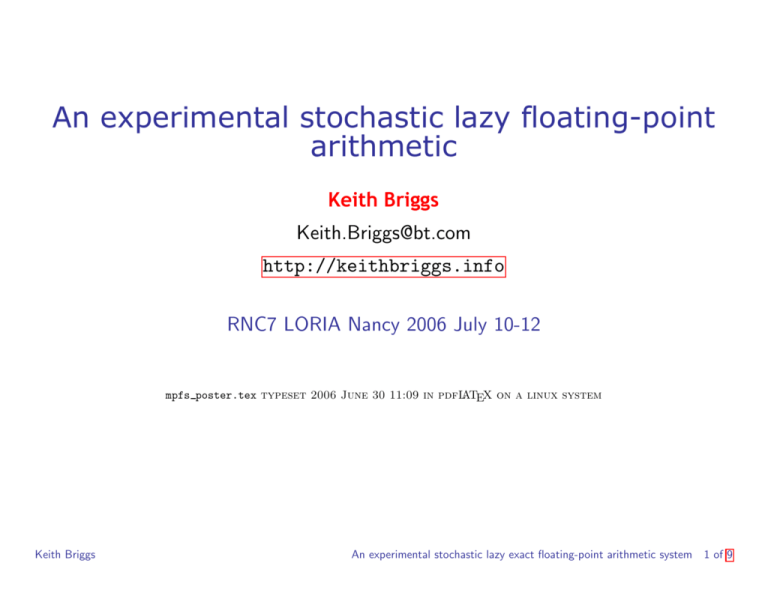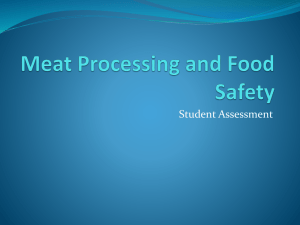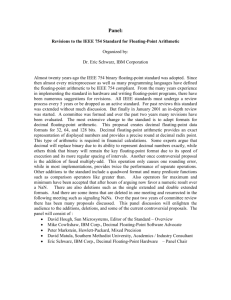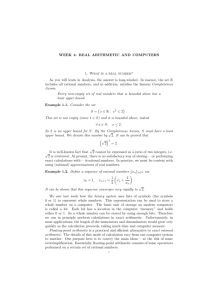An experimental stochastic lazy floating-point arithmetic
advertisement

An experimental stochastic lazy floating-point
arithmetic
Keith Briggs
Keith.Briggs@bt.com
http://keithbriggs.info
RNC7 LORIA Nancy 2006 July 10-12
mpfs poster.tex typeset 2006 June 30 11:09 in pdfLATEX on a linux system
Keith Briggs
An experimental stochastic lazy exact floating-point arithmetic system
1 of 9
Introduction and aim
F
F
F
We are concerned here only with problems of the type "determine
rigorously whether x < y or not", where x and y are computed
floating-point numbers. Such a truth value can in principle be
decided by a computation which terminates in finite time, assuming x and y are not equal. Problems of this type occur in
computational number theory and computational geometry.
Simple example: straight line through (x1, y1), (x2, y2); is the point
(x0, y0) to the left or right of the line? This is determined by
sign ((y1 −y0)(x2 −x1)−(x1 −x0)(y2 −y1)).
Related problems include computing the floor of a computed real,
and the continued fraction of an irrational (which needs the floor
function).
Aim: to produce a software library in C which is easy-to-use and is as
efficient as possible
Keith Briggs
An experimental stochastic lazy exact floating-point arithmetic system
2 of 9
Previous work
F
F
Heuristic (avoiding the real problem): set a precision level for
the whole computation. Record the result. Repeat the whole
computation at a higher precision. If the result doesn't change,
it's probably correct. (maple, mathematica?)
Exact real arithmetic: there have been many attempts at this:
. Essentially, these methods use lazy evaluation where the whole directed acyclic
graph (DAG) representing the computation is stored, and intermediate results
are re-evaluated as needed. Each step is performed with a bounded error, so
the final error is bounded. The main problems in practice concern the storage
required to store the DAG, and the fact that the error bounds are typically
too pessimistic. In many cases, the minimum possible "graininess" of 1 bit (the
smallest possible increase in precision per step) is larger than is actually needed
to satisfy error bounds. In large calculations, this can result in unacceptable
inefficiencies.
. XR - in C++ (with functional library) and python
. xrc - in C, using scaled-integer representation
. other authors - Boehm, Ménissier-Morain, Harrison, Potts etc.
Keith Briggs
An experimental stochastic lazy exact floating-point arithmetic system
3 of 9
Data flow example
F
find the sign of one root x =
ax2 +bx+c = 0
√
−b+ b2−4ac
2a
2
of the quadratic
a
*
b
4
c
sqr
*
*
-
sqrt
-
/
output
. input nodes don't know how much precision to send
. all input nodes send data, even if it eventually may not be needed
. to recalculate requires the whole tree to be re-evaluated
Keith Briggs
An experimental stochastic lazy exact floating-point arithmetic system
4 of 9
The idea
F
F
F
The present method is an experimental stochastic variation of
exact real arithmetic. The novelty is a way to avoid the 1-bit
graininess mentioned above. It is assumed that arbitrary precision
floating-point arithmetic with correct rounding is available (such
as provided by mpfr).
The complete DAG is stored.
The intermediate value at each node is a floating-point approximation x and absolute error bound δ . The interval [x−δ, x+δ]
always strictly bounds the correct result, and will be refined
automatically as necessary.
F
General idea: recompute to higher precision - on demand, but
transparently.
F
Nodes cache the most precise value so far computed.
F
The emphasis everywhere is on practicality, not theoretical elegance.
Keith Briggs
An experimental stochastic lazy exact floating-point arithmetic system
5 of 9
Error propagation
F
Definitions: exact number x̌, computed approximation x, error
bound δx > |x− x̌|, mantissa precision px, exponent ex, unit
roundoff ux = 2ex−px (for x 6= 0), N =round-to-nearest.
F
z = N (x±y): δz 6 uz /2+δx +δy
F
z = N (x∗y): δz 6 uz /2+(1+δy 2−ey )|y|δx +(1+δx2−ex )|x|δy
F
z = N (x1/2): δz 6 uz /2+δx/(x1/2(1+(1−21−px )1/2))
F
z = N (log(x)): δz 6 uz /2+δx/x
F
and so on - difficult cases include asin near ±1.
F
implemented in an mpfre layer: floating point real + error bound.
F
typically 32 bits are enough for the error bound.
F
tradeoffs are possible here - tighter bounds need more computing.
Keith Briggs
An experimental stochastic lazy exact floating-point arithmetic system
6 of 9
Evaluation
F
When evaluation is initiated, the increase in precision as we
move away from the output node is probabilistic, controlled by a
parameter α.
. The optimum value (i.e. that minimizing computation time) for α will depend
on the problem, but the final results are independent of α.
. If α < 1, then 1 bit of precision is added with probability α.
. If α > 1, then bαc bits are added.
. This allows tuning - for example, for the logistic map (4x(1−x)) problem, we
know that α = 1 should be optimal, because the Liapunov exponent is such that
one bit is lost on average per iteration.
F
The results of evaluation-initiating functions (i.e. comparison and
floor) are guaranteed correct.
F
In essence, the software implements an interpreter with evaluateon-demand semantics. This is hidden from the user.
Keith Briggs
An experimental stochastic lazy exact floating-point arithmetic system
7 of 9
Heuristics
F
F
F
F
The stochastic component is a heuristic.
reasonable?
Why might this be
One answer is already given above - error bounds are always
pessimistic. Another answer is that computing error bounds itself
takes time.
My mpfs software has a two-level design - the lower level (mpfre)
computes error bounds, but cannot guarantee to meet a demand
for an error bound to be less than a specified value; the upper
layer (the only layer with which the user interacts) recomputes on
demand to ensure that the truth value of comparisons is computed
correctly.
It is not considered a reasonable aim to provide a function to
compute a decimal representation of an output to a specified
number n of decimal places. However (especially for debugging)
a function mpfs out str is provided, which recomputes until a
relative error of about 10−n is achieved.
Keith Briggs
An experimental stochastic lazy exact floating-point arithmetic system
8 of 9
Example
F
F
Function names follow mpfr conventions, except that all outputs are return values.
Thus, for z = x + y we write
mpfr add(z,x,y,GMP RNDN); but z=mpfs add(x,y);.
/* mpfs which side of the line? example. sign((y 1-y 0)(x 2-x 1)-(x 1-x 0)(y 2-y 1)) */
#include "mpfs.h"
int main() {
mpfs t d,
x0=mpfs set si(. . .), y0=mpfs set si(. . .), /* test point */
x1=mpfs set si(. . .), x2=mpfs set si(. . .), /* 1st point on line */
y1=mpfs set si(. . .), y2=mpfs set si(. . .); /* 2nd point on line */
d=mpfs sub(
mpfs mul(mpfs sub(y1,y0),mpfs sub(x2,x1)),
mpfs mul(mpfs sub(x1,x0),mpfs sub(y2,y1))
);
printf("sign=%d\n",mpfs cmp ui(d,0));
return 0;
}
F
Tests (mpfs-0.9) on a range of specific problems indicate a
performance comparable to hand-tuned codes.
Keith Briggs
An experimental stochastic lazy exact floating-point arithmetic system
9 of 9








